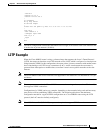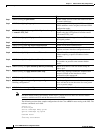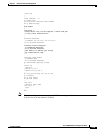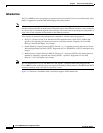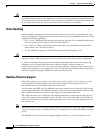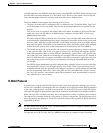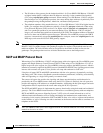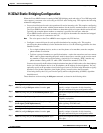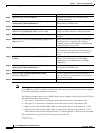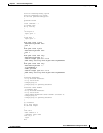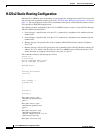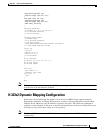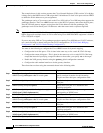
4-5
Cisco uBR924 Software Configuration Guide
OL-0337-05 (8/2002)
Chapter 4 Voice over IP Configurations
Overview
available when the Cisco uBR924 router interoperates with a DOCSIS 1.0 CMTS. In this situation, voice
and data traffic are both transmitted on a “best effort” basis. This may cause poorer voice quality and
lower data throughput when calls are being made from the router’s telephone ports.
The Cisco uBR924 router supports the following service classes:
• The first CoS in the router’s configuration file is configured as the “Tiered Best Effort Type Class”
and is the default CoS for data traffic. The class has no minimum upstream rate specified for the
channel.
This service class is assigned to the primary SID for the router. In addition to being used for data
traffic, the router uses this SID for all MAC message exchanges with the CMTS, as well as for
SNMP management traffic.
All traffic using this SID is transmitted on a “best effort” basis, but data traffic within this class can
be prioritized into eight different priority levels; although all data traffic still has lower priority than
the voice traffic, this allows certain data traffic (such as MAC messages) to be given higher priority
than other data traffic. The CMTS system administrator defines the traffic priority levels and must
include the traffic priority fields in the configuration file downloaded to the Cisco uBR924.
• The second and third CoS are for the first and second voice ports, respectively, which are assigned
to the secondary SIDs used for the voice ports. If using a Cisco IOS image that supports dynamic
multi-SID assignment, these secondary SIDs are automatically created when a call is placed from
one of the voice ports; when the call terminates, the secondary SID associated with it is deleted. If
the Cisco IOS image does not support multi-SIDs, static SIDs are created for each of the voice ports
during the power-on provisioning process, permanently reserving the bandwidth needed for the
voice traffic.
The CMTS system administrator typically configures these secondary classes of service so that they
have higher QoS classes for use by higher priority voice traffic. These classes should also have a
minimum upstream data rate specified for the channel to guarantee a specific amount of bandwidth
for the corresponding traffic flows. When static SIDs are used, that bandwidth is always reserved
for voice calls; however, when dynamic multi-SID assignment is used, that bandwidth is reserved
only when the voice calls are active.
H.323v2 Protocol
In architectures using the VoIP H.323v2 protocol stack, the session application manages two call legs
for each call: a telephony leg managed by the voice telephony service provider and the VoIP leg managed
by the cable system operator—the VoIP service provider. Use of the H.323v2 protocol typically requires
a dial plan and mapper at the headend or other server location to map IP addresses to telephone numbers.
When both legs of the call have been setup, the session application creates a conference between them.
The opposite leg’s transmit routine for voice packets is given to each provider. The CMTS router passes
data to the gateway and gatekeeper. The H.323v2 protocol stack provides signaling via H.225 and feature
negotiation via H.245.
Note For more information on using H.323v2, see the document H.323 Version 2 Support, available on CCO
and the Documentation CD-ROM.
To make and receive H.323 calls, the Cisco uBR924 router must be configured for the following:



